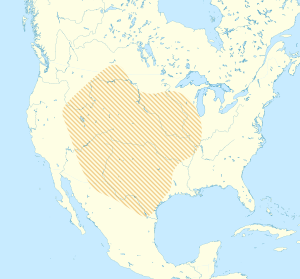Folsom tradition facts for kids

Map of Folsom tradition (modern shoreline shown)
|
|
| Geographical range | Great Plains |
|---|---|
| Period | Archaic |
| Dates | c. 8500 - 4000 BCE |
| Type site | Folsom site |
| Preceded by | Clovis culture |
The Folsom Complex was an ancient group of people who lived in central North America. They were part of the Paleo-Indian culture, which means they were some of the earliest people to live on the continent. They lived from about 8500 BCE to 4000 BCE. BCE stands for "Before Common Era," which is the same as BC. The name "Folsom" was first used in 1927 by Jesse Dade Figgins, who was the director of the Colorado Museum of Natural History.
Contents
Who Were the Folsom People?
The Folsom people were hunter-gatherers. This means they hunted animals for food and gathered plants. They lived across a large area, mainly in the Great Plains region of what is now the United States and Canada. They are known for their special tools, especially their spear tips called Folsom points.
Folsom Points: Their Special Tools
Folsom points are very unique spear tips. They are thin and have a groove, or "flute," running down the middle on both sides. This design made them lighter and easier to attach to a spear shaft. These points were very effective for hunting large animals.
What Did They Eat?
The Folsom people were skilled hunters. Their main food source was bison, a type of large wild cattle. They would hunt bison at special places called "kill sites." At these sites, they would kill the animals and then butcher them, meaning they would cut up the meat. Archaeologists have found evidence at some kill sites that up to 50 bison were killed at once!
Besides bison, the Folsom diet also included other animals. They hunted mountain sheep, marmots, deer, and cottontail rabbits. This shows they were good at hunting different kinds of animals in their environment.
Where Did They Live?
While the Folsom people moved around a lot to follow animal herds, they also had places where they stayed for a while. At the Hanson Site in Wyoming, archaeologists found areas of hard ground. These areas might have been where they built their homes or shelters.
Important Folsom Sites
Archaeologists learn about ancient cultures by studying the places where they lived and left behind tools.
The Folsom Site
The most important site for the Folsom culture is called the Folsom site. It's located near Folsom, New Mexico. This site was a "kill site" next to a marsh. It was first found around 1908 by George McJunkin. He was a cowboy and a former slave. Archaeologists started digging at the site in 1926. This site helped prove that people lived in North America much earlier than many scientists had thought.
The Lindenmeier Site
Another important site is the Lindenmeier site in Colorado. This was a campsite that the Folsom people used for a long time. Studying sites like Lindenmeier helps us understand how they lived day-to-day, not just how they hunted.
When Did the Folsom Culture Exist?
The Folsom Complex existed between 9000 BCE and 8000 BCE. Scientists believe that the Folsom culture developed from an even older culture called the Clovis culture. The Clovis people were also early inhabitants of North America, known for their own distinct spear points.
See also
 In Spanish: Cultura Folsom para niños
In Spanish: Cultura Folsom para niños


